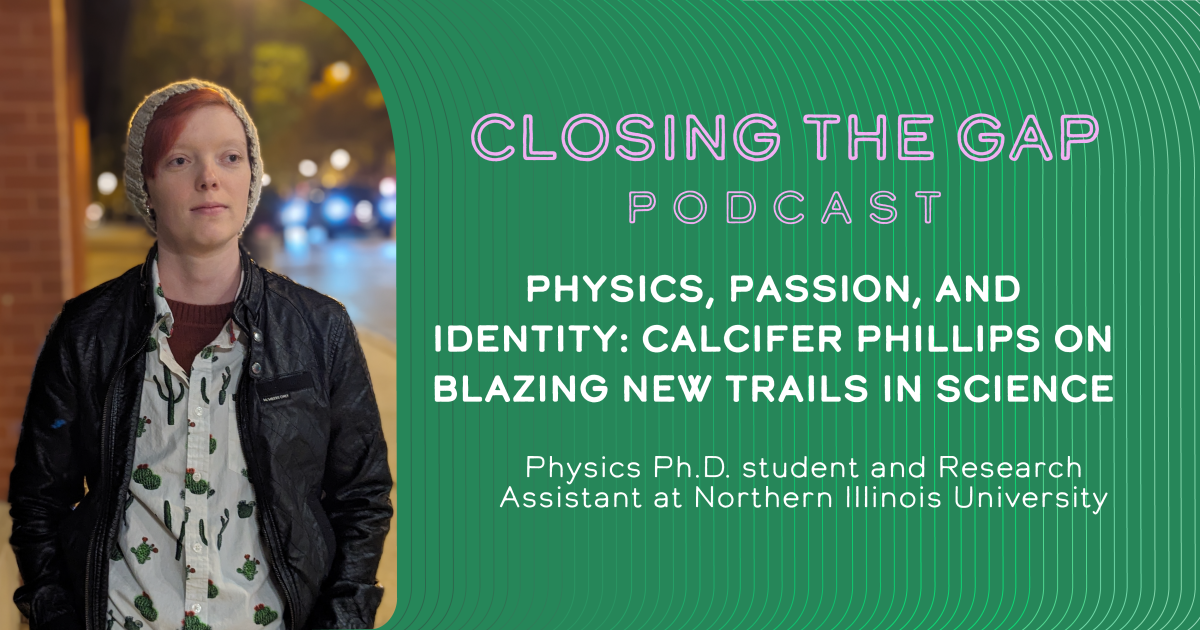Calcifer Phillips (they/them), a student and research assistant at Northern Illinois University in Chicago, joins us on Closing the Gap to discuss their experience as a nonbinary individual pursuing a Ph.D. in physics.
CTG: What’s your educational pathway been like up to this point?
Calcifer Phillips: I am currently a physics PhD candidate. I completed a bachelor’s in science in Physics, a bachelor’s of arts in Foreign Languages and Cultures in Spanish, and a master of science in physics
CTG: Tell us a bit about what you do for a living.
CP: Simple answer: I’m working on a potentially new way of accelerating electron bunches so that we can, potentially, create smaller and cheaper particle accelerators. The more complicated answer: I’m using dielectric tubes coated in a conductor material to better understand the potential for particle acceleration. An electron bunch travels through the tube and excites an electromagnetic wave behind it, which can be used to accelerate a second bunch behind it.
CTG: Tell us how you became interested in your current field and what inspired you to pursue it.
CP: I participated in the Lee Teng accelerator internship at Argonne National Lab. As part of it, they sent me to the US Particle Accelerator School, which is a two-week school with various classes. I really enjoyed the laser and accelerator aspects, so I looked at schools in the Chicago area with connections to Argonne National Laboratory and kind of fell into the Chicagoland Accelerator Science Traineeship (CAST).
CTG: What do you think young women and gender minorities should know about your area of expertise? How can this help them as they prepare for the workforce?
CP: Take advantage of every opportunity you can find and do your research to find them. This will give you networking opportunities that are very important in accelerator physics as well as general physics. Foster relationships with your advisors, and make sure your name is known. It’s all about who you know in the field, so email people. There are plenty of resources online about how to initiate contact with researchers.
CTG: Do you have advice you can give to young women and gender minorities who may be trying to navigate a career path similar to yours?
CP: I think one of the most important things to do is to have hobbies outside your degree and to foster relationships with people. Other students can be immature, and having people outside the department you’re part of can help you deal with interpersonal issues.
Resources for Women and Gender Minorities in Physics:
- CU*IP (formally CUWIP): Conference for Undergraduate Women and Gender Minorities In Physics; a conference for physicists to grow their networks, present research, and learn about the status of inclusivity in the field of physics.
- Lee Teng Internship: Lee Teng was a renowned accelerator physicist; this internship helps undergraduates get started in the field.
- US Particle Accelerator School (USPAS): A two-week program featuring intensive coursework. This opportunity is mainly available to graduate students and people working in the field. A prerequisite of getting a job in the accelerator physics field. Chicagoland Accelerator Student Traineeship (CAST): Offers funding opportunities for graduate students going into accelerator/beam physics at either Northern Illinois University or Illinois Institute of Technology.
- The International Society of Nonbinary Scientists: An organization providing community and resources for nonbinary people navigating the educational and career pathways in the science fields.
Articles:
- https://www.aps.org/publications/reports/lgbt-climate-in-physics
- https://www.aps.org/apsnews/2022/10/mixed-progress-women-marginalized


